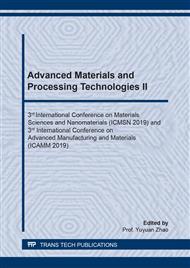[1]
T. Sinmazçelik, E. Avcu, M. Bora, O. Çoban, A review: Fibre metal laminates, background, bonding types and applied test methods. Materials & Design, 32: 7 (2011) 3671-3685.
DOI: 10.1016/j.matdes.2011.03.011
Google Scholar
[2]
A. Asundi, A. Y. N. Choi, Fiber metal laminates: An advanced material for future aircraft. Journal of Materials Processing Technology, 63: 1–3 (1997) 384-394.
DOI: 10.1016/s0924-0136(96)02652-0
Google Scholar
[3]
M. Sadighi, R.C. Alderliesten, R. Benedictus, Impact resistance of fiber-metal laminates: A review. International Journal of Impact Engineering, 49 (2012) 77-90.
DOI: 10.1016/j.ijimpeng.2012.05.006
Google Scholar
[4]
J. SINKE, Manufacturing of GLARE Parts and Structures, Applied Composite Materials. 10 (2003) 293-305.
Google Scholar
[5]
M. V. C. Alfaro, A. S. J. Suiker, R. Borst, J. J. C. Remmers, Analysis of fracture and delamination in laminates using 3D numerical modelling, Engineering Fracture Mechanics. 76 (2009) 761-780.
DOI: 10.1016/j.engfracmech.2008.09.002
Google Scholar
[6]
L. Mosse, P. Compston, W. J. Cantwell, The effect of process temperature on the formability of polypropylene based fibre–metal laminates. Composites Part A (Applied Science and Manufacturing), 36:8 (2005) 0-1166.
DOI: 10.1016/j.compositesa.2005.01.009
Google Scholar
[7]
L. Mosse, P. Compston, W. J. Cantwell, M. Cardew-Hall, S. Kalyanasundaram, Stamp forming of polypropylene based fiber–metal laminates: The effect of process variables on formability. J.Mater. Process. Technol. 172(2006) 163–168.
DOI: 10.1016/j.jmatprotec.2005.09.002
Google Scholar
[8]
S. Liu, L. Lang, E. sherkatghanad, Y. Wang, W. Xu, Investigation into the Fiber Orientation Effect on the Formability of GLARE Materials in the Stamp Forming Process. Applied Composite Materials, 25:2 (2018) 255-267.
DOI: 10.1007/s10443-017-9615-7
Google Scholar
[9]
J. W. Ma, N. K. Gao, T. Y. Ren, Z. H. Pan, H. Y. Jin, Influence of the morphology of alumina filler on electrical and thermal properties of epoxy resin composites. Materials Science Forum. (2018).
DOI: 10.4028/www.scientific.net/msf.922.163
Google Scholar
[10]
E. Sherkatghanad, L. Lang, S. Liu, Y. Wang, An innovative approach to mass production of fiber metal laminate sheets." Materials and Manufacturing Processes, 10426914 (2017) 1364864.
DOI: 10.1080/10426914.2017.1364864
Google Scholar
[11]
M. F. ZHAO, TAKEDA, Effect of interfacial adhesion and statistical fiber strength on tensile strength of unidirectional glass fiber/epoxy composites. Part. II: Comparison with prediction. Composites Part A (Applied Science and Manufacturing), 31:11(2000) 1203-1214.
DOI: 10.1016/s1359-835x(00)00085-3
Google Scholar
[12]
A. Gherissi, F. Abbassi, A. Ammar, A. Zghal, Numerical and Experimental Investigations on Deep Drawing of G1151 Carbon Fiber Woven Composites, Applied Composite Materials, 23:3 (2016) 461-476.
DOI: 10.1007/s10443-015-9468-x
Google Scholar


